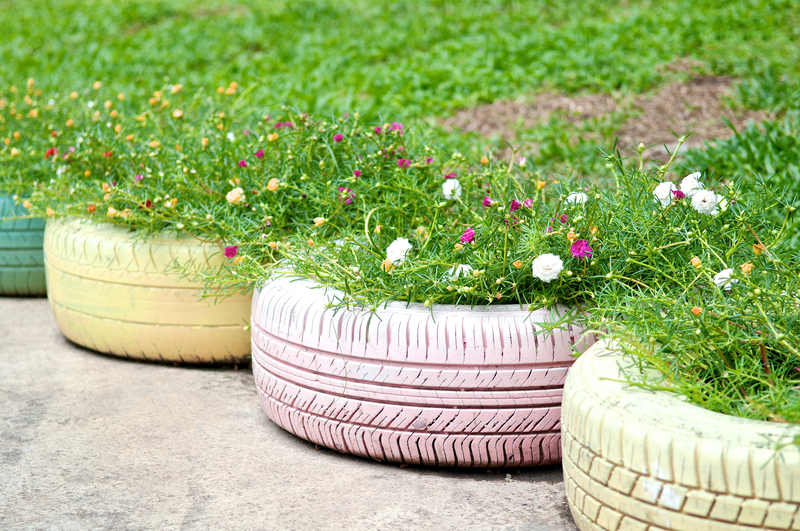Smart Tips For Home Recycling Improvement
Making your home's recycling habits more effective isn't just good for the planet, it can also save you time, reduce clutter, and even lower your waste disposal costs. With growing global concerns about waste management and resource conservation, improving home recycling is more important than ever. This comprehensive guide reveals actionable, smart tips for turning your household into an eco-friendly powerhouse of recycling efficiency.

Why Home Recycling Improvement Matters
The average household generates hundreds of pounds of waste every year, with much of it recyclable. Yet, without organized, well-informed recycling efforts, valuable materials can end up in landfills, contributing to pollution and wasted resources. Enhancing your home recycling approach not only benefits the environment but can also influence your local community through responsible practices.
Benefits of Upgrading Your Home Recycling Routine
- Reduces waste sent to landfills
- Conserves natural resources
- Encourages mindful consumption
- May decrease trash collection costs
- Supports local recycling industries
Understanding What You Can (and Can't) Recycle
The first step in any recycling improvement plan is knowing what you can actually recycle. Misplaced items in recycling bins can contaminate other recyclables, undermining your best intentions. Always consult your municipality's guidelines, but here's a general breakdown:
Commonly Accepted Recyclables:
- Paper Products: Newspapers, magazines, office paper, cardboard
- Plastics: Check numbered symbols (often #1 and #2 are accepted)
- Metals: Aluminum cans, tin cans, some kitchen foil
- Glass: Bottles and jars, usually color sorted
Items Often Not Recyclable:
- Plastic bags (take to store collection bins)
- Greasy pizza boxes or dirty food containers
- Ceramics, Pyrex glass, or windows
- Styrofoam (unless municipality specifies)
- Batteries, electronics (require special disposal)
Smart Tips For Improving Household Recycling
1. Set Up an Efficient Recycling Center at Home
Having the right setup can drastically increase participation and effectiveness. Consider the following:
- Accessible Location: Place recycling bins in a central area like the kitchen or garage.
- Label bins clearly for paper, plastic, metal, and glass.
- Use color-coded containers for quick sorting.
- Provide a cheat sheet with accepted materials above the bins.
2. Know Your Local Recycling Rules
Every town or city has unique rules. Visit your municipality's website to learn:
- What materials are collected curbside
- If items need to be cleaned or sorted
- Special guidelines for electronics, hazardous waste, or bulky items
- Proper recycling days or schedules
Optimizing home recycling starts with being informed and proactive.
3. Rinse and Clean Recyclables
Food and drink residue can contaminate an entire batch of recycling. Always rinse cans, bottles, and containers before tossing them in the bin. This protects the recycling stream and makes sorting easier for facilities.
4. Flatten Boxes and Containers
Maximize your bin space by crushing boxes and flattening containers. This simple habit makes collection more efficient and ensures more items can fit in your bins.
5. Avoid Wishcycling
Wishcycling is when you toss items in the recycling bin hoping they're recyclable. Unfortunately, this often leads to contamination. When in doubt, leave it out or check with your local waste management authority.
6. Get the Whole Family Involved
Recycling improvement at home is a team effort. Teach kids about different materials, quiz them on sorting, and reward correct recycling habits. Leading by example inspires lifelong earth-friendly behaviors.
7. Repurpose and Reuse Before Recycling
Some of the best smart tips for home recycling involve rethinking "single-use." For instance:
- Reuse jars and containers for storage
- Turn old t-shirts into cleaning rags
- Use delivery boxes for DIY projects
Remember: Reusing often saves more energy than recycling!
Innovative Technology For Home Recycling Improvement
Smart Recycling Bins
Technology is revolutionizing household recycling. Smart recycling bins feature:
- Sensors to detect contaminants
- Compaction to maximize space
- Notifications when bins need emptying
- Integrated sorting features for easy separation
While initial costs are higher, these solutions make recycling improvement effortless and can increase your family's recycling rate.
Apps For Recycling Education and Scheduling
Use your phone's app store to find recycling reminder and education apps. Many offer:
- Material lookup databases
- Pickup schedule reminders
- Guides for hard-to-recycle items
- Points and rewards for consistent recycling
Smart Weighing Scales and Trackers
Monitor home recycling improvement progress with connected scales that track how much you recycle over time. Set goals, view your impact, and even compete with friends and neighbors!
Advanced Tips for Home Recycling Efficiency
Compost Organic Waste
Composting isn't technically recycling, but it's an essential part of a zero-waste household. Create a small bin for food scraps and yard trimmings. Finished compost can be used in gardens and potted plants -- a win-win for waste reduction and homegrown nutrition.
Manage E-Waste Responsibly
Electronics should never go in regular recycling. Organize a box for e-waste -- phones, batteries, cables. Schedule periodic trips to an electronics recycling center to ensure these materials are disposed of safely, avoiding toxins entering the environment.
Stay Up-To-Date With Local Programs
Many cities offer periodic recycling events for hazardous items, clothing, textiles, or even holiday lights. Sign up for newsletters or city alerts so you never miss a chance to recycle those tricky items.
Reduce Single-Use Plastics
The best way to recycle is to avoid unnecessary packaging in the first place. Switch to reusable bags, bottles, and containers. Choose products with minimal, recyclable packaging. Every purchase is a vote for sustainable, recyclable goods.
How To Track and Improve Your Home Recycling Over Time
Set Achievable Goals
As with any habit, goals help nurture improvement. Decide on benchmarks -- such as reducing landfill waste by 25%, recycling a certain amount per month, or participating in a local collection every quarter. Write goals down and celebrate milestones.
Audit Your Waste Periodically
Make a monthly or quarterly habit to review your trash and recycling output. Notice patterns: Are you throwing away a lot of plastic packaging? Are recyclables ending up in the trash? Identifying these habits makes targeted improvement far easier!
Join a Community Challenge
Many cities, neighborhoods, or online groups host recycling competitions. Get involved for fun, friendly accountability and new ideas.

Common Recycling Mistakes - And How to Fix Them
- Putting plastic bags in curbside recycling: Many facilities cannot process bags -- return them to grocery stores instead.
- Leaving food residue: Always rinse to prevent contamination.
- Including unaccepted plastics or styrofoam: Check the numbering system and your city's rules.
- Recycling hazardous materials like batteries, which require special handling.
A quick refresher for your household can make a big difference in your overall impact.
Conclusion: Sustainable Success Starts at Home
Smart tips for home recycling improvement aren't just theoretical--they're practical changes that any family can make. By integrating organization, education, community involvement, and emerging technology, you'll drastically enhance your home's recycling habits. Remember:
- Set up accessible recycling stations
- Always check your local guidelines
- Rinse, sort, and flatten your recyclables
- Prioritize reuse before recycling
- Leverage smart tools and community programs
If every household implements even a few of these strategies, the collective impact will be immense. Whether you're just getting started or looking to refresh your approach, these smart tips for home recycling improvement ensure that doing your part for the environment is easier--and more rewarding--than ever.